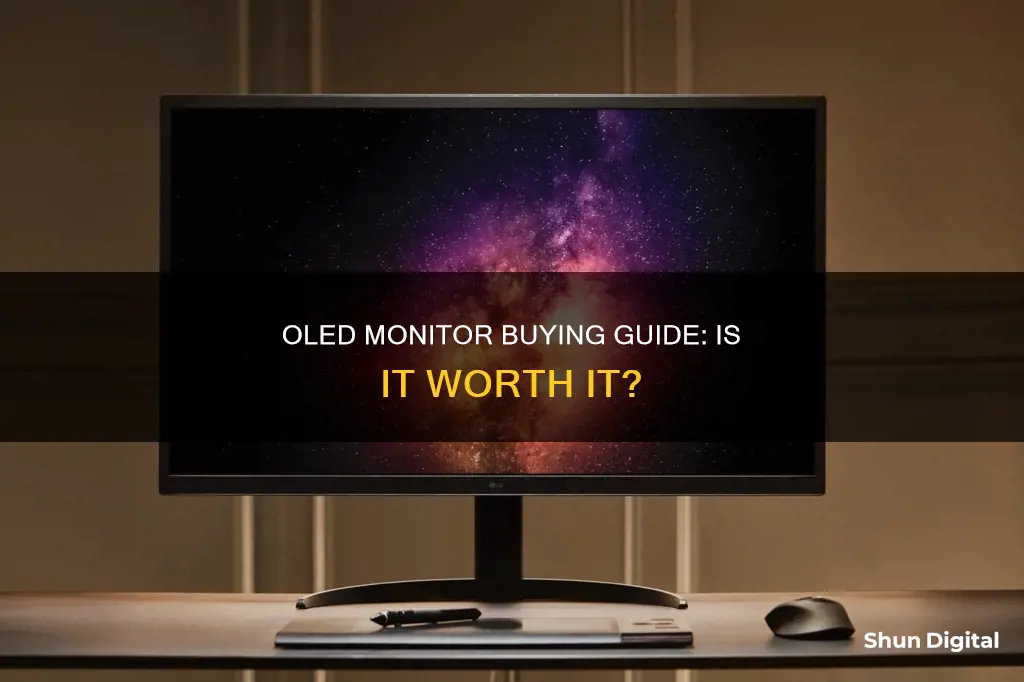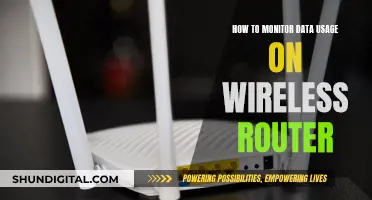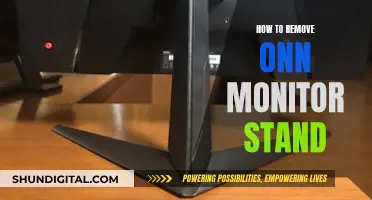
OLED monitors are becoming an increasingly popular choice for gamers, but are they worth the money? With their superior image quality, lightning-fast response times, and immersive viewing experience, they certainly make a compelling case for users seeking the best display performance. However, OLED monitors also come with a higher price tag and concerns about burn-in. So, should you buy an OLED monitor? Let's explore the pros and cons to help you decide.
| Characteristics | Values |
|---|---|
| Blacks and Contrast | OLED monitors offer true blacks and stunning contrast for an immersive viewing experience unmatched by traditional panels. |
| Pixel Response Times | OLED monitors have lightning-fast pixel response times, eliminating ghosting and blurring during fast-paced action in games. |
| Brightness | New OLED monitors are brighter than ever, with improved peak brightness and HDR performance, closing the gap on LCD displays. |
| Affordability | OLED monitors are becoming more affordable, with budget-conscious manufacturers bringing prices down. |
| Burn-In | Burn-in is no longer an issue, with most newer OLED displays having built-in measures to prevent it. |
What You'll Learn

True Blacks and Stunning Contrast
OLED monitors are known for their ability to produce "true blacks" and stunning contrast, a feature that sets them apart from traditional panels and other display technologies such as LCD, IPS, and VA. This is achieved through the unique way OLED displays function, with each pixel emitting its own light, allowing for an infinite contrast ratio and stunning image quality.
The allure of OLED technology lies in its deep black levels, which are achieved by individually turning off each pixel when displaying dark scenes. This results in true blacks, as OLEDs can get extremely dark, creating an inky depth that other display technologies struggle to match. In comparison, LCDs use a backlight that remains on even during dark scenes, allowing some light to bleed through the panel, resulting in a greyish cast.
The absence of a backlight in OLED monitors means that vibrant colours and highlights stand out, creating a mesmerizing and immersive viewing experience. Additionally, colours remain accurate and consistent from every angle, making OLEDs ideal for local co-op gaming with friends. The superior contrast and black levels of OLEDs are further enhanced by their instantaneous pixel response time, ensuring no noticeable ghosting or overshoot behind fast-moving objects, regardless of the refresh rate.
While OLED displays offer unparalleled black levels and contrast, it is important to consider external factors that may impact the viewing experience. For example, ambient lighting conditions, the location of light sources, and the coating on the screen surface can all affect how internal and external light is handled, potentially influencing the perceived black depth and contrast.
In summary, OLED monitors deliver true blacks and stunning contrast through their unique pixel-level light control, resulting in a viewing experience that is unmatched by traditional panels. However, it is important to be aware of potential drawbacks, such as image burn-in and the need for careful maintenance to extend the life of the display.
Choosing the Right Allen Key Size for Delta Monitor Faucet
You may want to see also

Lightning-Fast Pixel Response Times
OLED monitors have near-instantaneous pixel response times, which means that there is practically zero ghosting. This is a significant improvement over VA panels, which are known for their slow response times in darker transitions, leading to black smearing.
The pixel response time is the time it takes for a pixel to change from one colour to another. A quick pixel response time is needed to eliminate ghosting or trailing behind fast-moving objects in fast-paced games. The required response time depends on the monitor's maximum refresh rate. For example, a 60Hz monitor refreshes the image 60 times per second, with 16.67 milliseconds between each refresh. So, if a pixel takes longer than 16.67ms to change from one colour to another, you will notice ghosting.
OLED monitors have a much faster response time than this, with one user reporting that their OLED monitor has a response time of 1.3ms for pixels to change from an RGB value of 153 to RGB 102. This is an excellent result for a 360Hz display with a 2.78ms refresh rate cycle.
The fast response time of OLED monitors means that motion looks smooth, with minimal motion blur. This is especially beneficial for gamers and sports fans, who will be viewing content with fast-moving objects.
Setting Up Monitors with a Mackie Mixer: A Guide
You may want to see also

New OLED Monitors Are Brighter Than Ever
OLED monitors have been making waves in the gaming world, but there's been a common criticism that they're too dim. However, new OLED monitors are brighter than ever, and this article will explore how they're keeping up with LCD monitors in terms of brightness while offering their unique benefits.
The Science Behind OLED Brightness
OLED (Organic Light-Emitting Diode) and LCD (Liquid Crystal Display) monitors have fundamental differences. LCDs use a backlight, which can be blasted to achieve high brightness. In contrast, OLEDs don't have a backlight. Each pixel is its own self-emitting diode, and increasing brightness means sending more electrical current through these diodes, which can lead to issues.
The Trade-Off Between Brightness and Longevity
The brighter the OLED display, the higher the risk of burn-in. This is because the organic material that makes up OLED degrades faster when fed more current. So, it's a trade-off between brightness and longevity.
The Perceived Brightness of OLEDs
While OLED monitors are objectively dimmer, the perceived brightness is a different story. Due to their infinite contrast and self-emitting nature, OLEDs can give the effect of higher brightness. Other factors like viewing distance, screen size, and ambient light also influence how bright a monitor appears, not just the luminance meter reading.
The Latest OLED Offerings
The Samsung Odyssey OLED G8/G80SD S32DG80 is a great example of the new generation of OLED monitors. It's a 32-inch 4K QD-OLED (Quantum Dot OLED) with a 240Hz refresh rate, making it ideal for gamers. It offers vivid colors, bright highlights, and perfect blacks.
For esports enthusiasts, the LG 32GS95UE-B is a fantastic option. It's a 32-inch 4K WOLED (White OLED) with a 240Hz refresh rate. While colors aren't as vivid as QD-OLEDs, blacks remain deep even in bright rooms, ensuring consistent picture quality.
If you're looking for a smaller screen, the Gigabyte AORUS FO27Q3 is a 27-inch QD-OLED with a 1440p resolution and an impressive 360Hz refresh rate. It delivers sharp motion and vivid colors, making it a great choice for PC gaming.
For those who want more screen real estate, the Dell Alienware AW3423DWF is an excellent ultrawide option with a 21:9 aspect ratio and a QD-OLED panel. It has a lower 165Hz refresh rate but offers a more immersive gaming experience.
While OLED monitors have traditionally been dimmer, the latest models are brighter and more competitive with LCDs. With advancements in technology and a careful balance between brightness and longevity, OLEDs are becoming an even more attractive option for gamers and content creators alike.
Standard Monitor Size: Understanding the 1280x1024 Resolution
You may want to see also

OLED Monitors Are Becoming More Affordable
While OLED monitors have traditionally been expensive, with prices starting at over a thousand dollars, that is beginning to change. LG, the world's largest OLED manufacturer, has indicated that it is ready to start manufacturing smaller OLED panels for TVs and computer monitors. This shift towards smaller displays using cheaper WOLED panel technology will make OLED monitors more accessible to consumers.
In 2024, several new OLED monitors have been released, offering a range of features and specifications to cater to different needs and budgets. The Samsung Odyssey G8/G80SD S32DG80 is currently one of the best OLED monitors on the market, combining a 4K resolution with a 240Hz refresh rate, making it ideal for gamers. It also boasts vivid colors and bright highlights, as well as a built-in smart platform for content streaming.
For those looking for an OLED monitor specifically for esports gaming, the LG 32GS95UE-B is a great option. It has a Dual-Mode feature that allows users to switch between a 1080p resolution and 480Hz refresh rate, making it versatile for different gaming needs. Additionally, it displays deep blacks even in bright rooms, ensuring consistent picture quality.
If you're looking for a smaller screen, the Gigabyte AORUS FO27Q3 is a 27-inch QD-OLED monitor with a lower 1440p resolution. It still offers a sharp image and a fast 360Hz refresh rate, making it a good choice for PC gaming. This monitor also includes useful features like a KVM switch and a USB-C port.
For those who want an ultrawide OLED monitor, the Dell Alienware AW3423DWF is a great option. It has a QD-OLED panel, delivering excellent picture quality, and a 165Hz refresh rate, making it suitable for most gamers.
While OLED monitors are becoming more affordable, it's important to consider their potential downsides. OLEDs are prone to burn-in when exposed to the same static elements over time, so they may not be ideal if you plan to use them primarily for work. Additionally, some OLED monitors may have text rendering issues due to their subpixel layout, resulting in colorful fringes around text.
LCD Screens: Benefits of a Modern Display
You may want to see also

Burn-In Is No Longer an Issue
Burn-in is a common issue with OLED screens, where static images are displayed for long periods. This can include persistent icons on a phone, a channel logo, news ticker, or a scoreboard on a TV. While burn-in is a possibility with OLED screens, it is not a likely occurrence under normal use. Most cases of "burn-in" are actually image retention, which goes away after a few minutes and is not permanent.
OLED screens have improved over the years, and the risk of burn-in has decreased significantly. Newer screens have protections in place to prolong their lifespan. Additionally, OLED manufacturers have implemented features to mitigate burn-in, such as pixel shift, pixel refresh, and screen savers. For example, LG has a feature called "Daily Pixel Refresher," which automatically runs after the TV has been turned off for four hours, helping to prevent burn-in and image retention.
When it comes to gaming monitors, OLED screens may still be susceptible to burn-in due to static game menus and UI elements. However, if you vary your gaming habits and don't play the same game for excessive periods, the risk of burn-in is reduced.
Overall, while burn-in was once a significant concern for OLED screens, it is no longer a major issue. With normal use and some simple precautions, you can enjoy the benefits of OLED technology without worrying about burn-in.
Easy Steps to Connect Your TV as a Monitor
You may want to see also
Frequently asked questions
OLED monitors offer true blacks and stunning contrast for an immersive viewing experience unmatched by traditional panels. They also have lightning-fast pixel response times, eliminating ghosting and blurring during fast-paced action in games.
OLED monitors are becoming more affordable, with budget-conscious manufacturers bringing OLED monitors to the masses. However, they are still more expensive than IPS or VA panels, so it depends on your budget and needs.
Burn-in is when an image gets permanently burned into a display. It used to be a significant problem with OLED monitors, but newer models have built-in measures to prevent burn-in, and it's also covered by warranties from most manufacturers.
There are several OLED monitors available on the market, including the LG 32GS95UE, the AOC Agon Pro AG276QZD, and the Samsung Odyssey OLED G9.







